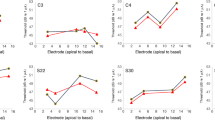Abstract
The effects of rise-fall and plateau times for the Pa component of the middle-latency response (MLR) were investigated in normally hearing subjects, and an objective MLR threshold was measured in patients with low- and middle-tone hearing losses, using a selected stimulus-envelope time. Our results showed that the stimulus-envelope time (the rise-fall time and plateau time groups) affected the Pa component of the MLR (quality was determined by the (χ2-test and amplitude by the F-test). The 4-2-4 tone-pips produced good Pa quality by visual inspection. However, our data revealed no statistically significant Na-Pa amplitude differences between the two subgroups studied when comparing the 2- and 4-ms rise-fall times and the 0- and 2-ms plateau times. In contrast, Na-Pa became significantly smaller from the 4-ms to the 6-ms rise-fall time and from the 2-ms to the 4-ms plateau time (paired t-test). This result allowed us to select the 2- or 4-ms rise-fall time and the 0- or 2-ms plateau time without influencing amplitude. Analysis of the stimulus spectral characteristics demonstrated that a rise-fall time of at least 2ms could prevent spectral splatter and indicated that a stimulus with a 5-ms rise-fall time had a greater frequency-specificity than a stimulus of 2-ms rise-fall time. When considering the synchronous discharge and frequency-specificity of MLR, our findings show that a rise-fall time of four periods with a plateau of two periods is an acceptable compromise for estimating the objective MLR threshold. The correspondence between MLR and pure-tone audiometric (PTA) thresholds was high, with a correlation coefficient around 0.92–0.96 in these cases with rising low- and middle-tone sensorineural hearing losses. The MLR and PTA thresholds were within 10 dB for all cases. A comparison of the mean difference (MLRt-PTAt) at 0.5, 1 and 2 kHz revealed no significant differences (F-test). The MLR threshold in the present study approximated the psychoacoustic threshold in the hearing-impaired subjects, while the MLR using 4-2-4 tone-pips was able to measure objective thresholds across low and middle frequencies. This study has again demonstrated the clinical usefulness of the MLR for estimating low- to middle-frequency auditory thresholds.
Similar content being viewed by others
References
Beattie RC, Moretti M, Warren V (1984) Effects of rise-fall time, frequency, and intensity on the early/middle evoked response. J Speech Hear Disord 49: 114–127
Burkard R (1984) Sound pressure level measurement and spectral analysis of brief acoustic transients. Electroencephalogr Clin Neurophysiol 57:83–91
Davis H, Hirsh SK, Popelka GR, Formly C (1984) Frequency selectivity and thresholds of brief stimuli suitable for electric response audiometry. Audiology 23: 59–74
Davis H, Hirsh SK, Turpin LL, Peacock ME (1985) Threshold sensitivity and frequency specificity in auditory brainstem response audiometry. Audiology 24: 54–70
Geisler CD, Frishkopt LS, Rosenblith WA (1958) Extracranial responses to acoustic clicks in man. Science 128: 1210–1211
Gorga MP, Abbas PJ, Worthington DW (1985) Stimulus calibration in ABR measurements. Audiology 23: 569–580
Hausler R, Magnin C, Mulette P (1991) Low frequency hearing threshold determination in newborns, infants and mentally retarded children by middle latency responses. Acta Otolaryngol (Stockh) [Suppl] 482: 58–71
Hecox K, Deegan F (1983) Rise-fall time effects on the brainstem auditory evoked response: mechanisms. J Acoust Soc Am 73:2109–2116
Jerger J, Mauldin L (1978) Prediction of sensorineural hearing level from the BSER. Arch Otolaryngol 104: 446–456
Kavanagh KT, Harker L, Tyler RS (1984) Auditory brainstem and middle latency responses. II. Threshold responses to a 500 Hz tonepip. Ann Otol Rhinol Laryngol [Suppl] 108: 1–12
Kodera K, Yamane N, Yamada O, Suzuki J (1977) The effect of onset, offset and rise-decay times of tone bursts on brain stem response. Scand Audiol 6: 205–210
Kodera K, Robert FH, Yamada O, Suzuki JI (1979) Effects of rise time on simultaneously recorded auditory evoked potentials from the early, middle and late ranges. Audiology 18: 395–402
Maurizi M, Ottavian F, Paludetti G, Rosignoli M, Almadori G, Tassoni A (1984) Middle latency auditory components in response to clicks and low- and middle frequency tone pips (0.51 kHz). Audiology 23: 569–580
McGee T, Kraus N, Manfredi C (1988) Toward a strategy for analyzing the auditory middle-latency responses waveform. Audiology 27: 119–130
McRandle CC (1974) Early averaged electroencephalic responses to clicks in neonates. Ann Otol Rhinol Laryngol 83: 695–702
Mendel MI, Arkinson CD (1977) Middle components of the auditory evoked potentials in infants. Ann Otol Rhinol Laryngol 86:293–299
Ozdamar O, Kraus N (1983) Auditory middle-latency response in human. Audiology 22: 34–49
Author information
Authors and Affiliations
Rights and permissions
About this article
Cite this article
Xu, Z.M., De Vel, E., Vinck, B. et al. Selecting the best tone-pip stimulus-envelope time for estimating an objective middle-latency response threshold for low- and middle-tone sensorineural hearing losses. Eur Arch Otorhinolaryngol 252, 275–279 (1995). https://doi.org/10.1007/BF00185389
Received:
Accepted:
Issue Date:
DOI: https://doi.org/10.1007/BF00185389




